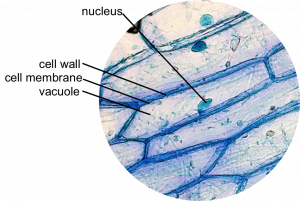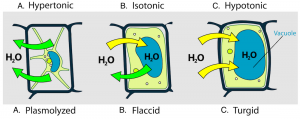Lesson 1 – MRS GREN
- 1 word describing your dominant emotion in the lesson – optimistic
We learnt about the seven characteristics of a living being.
M – movement, R – respiration, S – sensitivity, G – growth, R – reproduction, E – excretion, N – nutrition
In order for something to be ‘living’ it must consist of these seven things.
Lesson 2 – How big is a cell?
At first it was difficult for me to get a clear image of the onion cell using the microscope as I forgot the exact steps. I remembered up until the part of placing a good sample under the microscope but it was hard for me to adjust the focus to find the cell; we could only see a blurry green image.
By using the microscope to view the onion cell we could see lots of rectangular boxes and inside each of them it included a circle; the nucleus. There wasn’t any ‘new’ piece of knowledge I took in from the observations, however it was good to refresh my brain on how to use a microscope.
One question: What is the difference between plant cells and animal cells?
Lesson 3 – Plant vs Animal Cells
Surprisingly, this lesson was the exact answer to my question from the previous lesson. We looked at a plant cell and our cheek cell and compared the two. This time I was able to use the microscope effectively and I got a clear image of how the plant cell looked like. However, when finding the cheek cell, my partner and I were not successful in this. We tried about 3 times, just in case we weren’t following the instructions carefully but in the end we were not able to observe the cells under the microscope.
(magnification was 40x)
The leaf cell:
How the cheek cell would’ve looked like:
The formula for calculating the actual size of a cell, image size, magnification is:
For example for a cheek cell, the image size is 15mm (15000 micrometers) and the magnification was 400, the actual size would be 15000/400, thus, 37.5 micrometers.
Lesson 4 – Labelling plants and animals cells
In the previous lesson we started to compare the differences between plant and animal cells, in this lesson we explored the different sections and the roles of them for both cells. I already knew how in both plant and animal cells, it consists of a nucleus, cytoplasm, and a cell membrane.
Nucleus – controls the cell
Cytoplasm – where chemical reactions take place
Cell membrane – controls the movement of substances (in and out)
Cell wall – strengthens the cells, provides structure
Chloroplast – contains chlorophyll which absorbs light for photosynthesis
Vacuole – to support the cells structure
Mitochondria – most energy is released by respiration here
One thing that might be difficult is to not get ‘cell membrane’ and ‘cell wall’ mixed up. They seem very similar but they are two separate structures. I can try remember that the cell wall is on the outer most part and it helps provide structure, just like how it would be like in a house. (remember through similar concept)
Lesson 5 – Diffusion
Diffusion is the net movement of molecules from a region of their higher concentration to a region of their lower concentration down a concentration gradient, as a result of their random movement.
Key words: high to low
2 areas in the body where diffusion might be important:
diffusion in the lungs: carbon dioxide moves from the blood to the alveoli as blood returning to the lungs have a high concentration of carbon dioxide. There is more oxygen in the alveoli compared to the blood so the oxygen diffuses across the alveolar walls into the blood.
(exchange of gas, CO2 and O2)
Lesson 6 – Osmosis
Osmosis is the diffusion of water molecules from a region of their higher concentration (dilute solution) to a region of their lower concentration (concentrated solution), through a partially permeable membrane.
- watched video
- play (Quizlet)
- went through the booket
- worked trough the test
I think the video was useful because it explained diffusion and osmosis in a way I could easily understand and it provided examples so it helped to expand my thinking. I also think the Quizlet flashcards were really useful because I could test myself to see how much information I actually absorbed.
Focus: 4
Learning: 4
Time management: 3
Lesson 7 – Plasmolysis
Osmosis is an important process when considering the roots of a plant. Osmosis is the diffusion of water molecules from a region of their higher concentration to a region of their lower concentration. Root hair cells can absorb the water and send it to other parts of the plant through osmosis, they have a large surface area to speed up osmosis, the water moves from a place with higher concentration to inside the plant with lower concentration. As the water keeps getting transported to other parts of the plant, the water keeps flowing, therefore osmosis keeps occurring.
I think it can be confusing to remember “hypertonic” and “hypotonic”, which one is which. A way I could remember this is that “hyper” is “high” and “hypo” is “low”, therefore, hypertonic solution has higher concentration of solutes, hypotonic solution has lower concentration of solutes.
In a hypertonic solution, the cell loses water from the cell as the vacuole shrinks and the cell loses its shape. In a hypotonic solution, water particles move into the cell, the vacuole expands and pushes against the cell wall. In a isotonic solution, there is the same osmotic pressure across the semi permeable membrane, the concentration of solutes are both the same on either side.








